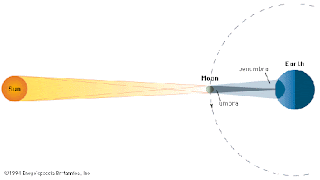(Definition and Meaning eclipse - solar eclipse and lunar eclipse) in circulation at one time the moon, the earth, and the sun will be in a straight line. At the time of the eclipse as it happens.
 |
| Lunar Eclipse Pictures |
Understanding Solar Eclipse
(Definition of Solar Eclipse) - Solar eclipse occurs when the moon is between the earth and the sun, the moon at the time of death, and the shadows in the shape of a cone covering the surface of the earth.
The shadows in two parts, the umbra and penumbra. Umbra is the dark and conical peak earthward. Penumbra is part of a rather light and shape the further widening of the month.
The area within the umbra coverage will experience a total solar eclipse, while those in the penumbra coverage experienced partial solar eclipse. In a total solar eclipse will be visible solar corona light that looks like a crown and bursts of gas from the surface of the sun colored red.
 |
| Lunar Eclipse Photo |
Understanding lunar eclipse
(Definition of lunar eclipse) - Lunar eclipse occurs when the earth is between the moon and the sun, which at the time of the full moon and the shadows of the earth surface cover months. Lunar eclipse can be seen clearly that the moon is covered by the shadow of the umbra. In the circulation around the earth, there are times when the moon moves into the region of shadows umbra, so that could be more than two hours in the dark. In such circumstances, there was a total lunar eclipse.
There are times in just over the edge of the section umbra shadow, so that the surface is only partially darkened. At the moment it looks like this is the lunar eclipse in part.
Illustration occurrence of lunar eclipse
Types of lunar eclipse
Based on the current state of the peak phase of the eclipse, lunar eclipses can be distinguished:
1. Total lunar eclipse
If the current phase of maximum eclipse eclipse, the entire moon into the shadow of the core / Earth's umbra, the eclipse is called a total lunar eclipse. This total lunar eclipse can reach a maximum duration of more than 1 hour 47 minutes.
2. Some lunar eclipses
If only part of the Moon are entered into the Earth's umbra, and some are in the shadow of additional / penumbra Earth at its maximum phase, the eclipse is called a partial lunar eclipse.
3. Total penumbral lunar eclipse
Lunar eclipse on the third type, the whole month into the penumbra at maximum phase. But no part of the Moon goes into the umbra or not covered by the penumbra. In cases like this, we call Eclipse month total penumbral lunar eclipse.
4. Some penumbral lunar eclipse
And the lunar eclipse this last type, if only a part of the Moon that enters penumbra, the lunar eclipse penumbral lunar eclipse is called partial.
Penumbral lunar eclipses are less attractive to the observer. Because the lunar eclipse of this type, the appearance of the eclipse is almost indistinguishable from normal during the full moon.
Meanwhile, based on the shape, there are three types of lunar eclipses, namely:
Type t, or a total lunar eclipse. Here, in all the way into the Earth's umbra cone.
P-type, or a partial lunar eclipse, when only a month into the Earth's umbra cone.
Type of pen, or penumbral lunar eclipse, when the moon entered the penumbra cone, but no part of the moon into the Earth's umbra cone.